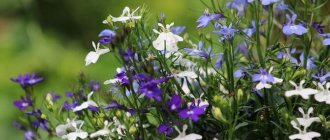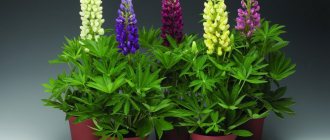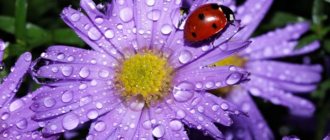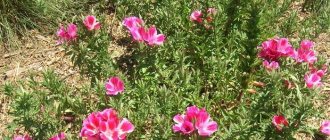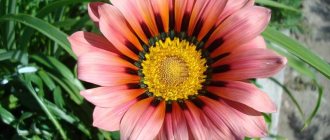Purslane, growing from seeds to seedlings at home which all flower lovers can do, is an ornamental vegetable ground cover plant. It can be grown even on poor soils. In addition, these flowers are unpretentious, drought-resistant and undemanding in care.
It is best to grow purslane from seeds and seedlings at home . Next we will talk about when and how to plant purslane and how to do it correctly.
Description and types of purslane, popular varieties
Purslane is a succulent plant, a herbaceous annual. It is widespread in the southern regions, where there is a warm climate. The plant forms a branched bush with a recumbent smooth stem of a reddish hue, up to 30 cm long. Leaves without cuttings, fleshy, ovate, look like spatulas.
The flowers of garden purslane are small (2-3 cm in diameter), simple, yellow in color. Decorative varieties have large flowers (up to 10 cm in diameter), bright, cup-shaped. The color of the petals can be white, red, pink, peach, orange. The buds bloom in June, flowering lasts until the end of summer. The seeds are collected in the fruit - a spherical box.
Purslane grandiflora is an attractive ornamental plant that decorates the flower garden until the first frost.
Purslane is divided into several types:
- Ampelous is a perennial hybrid species that is grown in open ground. The flowers are simple and come in various shades of red, white, purple and yellow. Flower growers plant ampelous purslane in hanging baskets and tall flowerpots so that the shoots hang beautifully.
- Garden purslane is an edible plant. It has beneficial and medicinal properties. The flowers of the plant are yellow and small in shape. The leaves are oval shaped and succulent.
Young leaves of garden purslane are used as food. They are put in salads, stews, seasonings, and pickled for the winter. In folk medicine, the plant is used externally as a wound-healing and anti-inflammatory agent. A decoction of seeds or leaves is taken internally to lower blood sugar levels, increase blood pressure and increase heart rate.
Purslane - food, healer, hormone of happiness and joy: video
- Large-flowered is a very popular species with a variety of flower colors. They decorate garden beds and are used to decorate summer cottages. In Russia, large-flowered purslane is grown as an annual plant.
- Terry is a variety of large-flowered purslane. The plant is low-growing with double flowers. Its most popular varieties are Splendence and White-flowered.
Popular varieties
Variety Splendex
- Red or scarlet purslane is one of the shortest among the representatives of the genus. The height of the branched bush is 12 cm. It is covered with small leaves and bright scarlet flowers, up to 5 cm in diameter. Flowering lasts until the first cold weather. The buds open only on a clear, sunny day.
- White purslane is attractive with large double flowers. The petals in the bud are snow-white, the core of the flower is bright yellow. The variety is characterized by rapid growth, reaching a diameter of 40 cm. The plant is resistant to heat and can grow on poor, rocky soil.
- Pun . A variety that includes plants with flowers of different colors and shapes (simple and double). The bush is creeping and can be planted as a ground cover.
- Sanglo. Purslane variety, with flowers up to 6 cm in diameter. They are densely terry, open even in cloudy weather. Colors: white, pink, yellow, red, salmon.
- The Splendex variety is characterized by purple-pink flowers, up to 4 cm in diameter. The height of the bushes is 10-12 cm.
- Flamenco. Purslane, 20 cm high and flowers of white, yellow, scarlet, pink color. The plant does not tolerate clay and damp soils and withstands drought well.
Variety Flamenco
The common feature for most varieties of purslane is prolonged flowering, until the arrival of frost, which will kill the plant. If you plant bushes in containers, you can prolong the bright flowering by placing the purslane in a warm place in the fall and providing lighting.
Brief characteristics of the plant
Purslane (Portulaca L.) is a genus of plants in the Portulaceae family. It covers about 100-150 species, widespread throughout the world, but most diverse in the tropical and subtropical zones, especially in Africa and South America. A widespread species in cultivation is the ornamental grandiflora purslane (P. grandiflora), originating from Brazil and Uruguay. In the south of Russia, Ukraine, and Belarus, only garden purslane (P. oleracea) grows wildly as a domesticated anthropophyte.
The scientific name comes from the Latin word portula, meaning “small door, door” in relation to the fruit’s lid – the capsule. Plants of this species grow mainly in rocky and ruderal places, often on roadsides, fields, and along river banks.
These are small (up to 30 cm), usually creeping annual plants. The only perennial is P. suffrutescens. The special, succulent stem structure helps the plant withstand harsh conditions. Its narrow, cylindrical, fleshy leaves and creeping shoots are completely covered with a waxy coating, which prevents the evaporation of water and promotes the accumulation of life-giving fluid in the tissues.
Morphology:
- Stems are recumbent, rarely raised, branched, fleshy, usually glabrous, sometimes with hairs at the nodes and inside the inflorescence.
- The leaves are fleshy, spiral (lower) or opposite (upper), usually sessile. Cylindrical or flattened sheet plate.
- Flowers are solitary, located at the ends of stems, branches, leaf axils, often very short, sometimes in the form of a head. The impressive perianth leaves usually open only in full sun. Depending on the variety, the flowers are white or can have various shades of yellow, pink, violet, purple, orange, red, and the colors of the delicate petals are often rich and expressive. Flowers also usually have an intense yellow "center" that emphasizes their decorative value. You can find plants with an original flower structure, two-color petals.
- The fruit is a capsule, usually spherical, containing numerous seeds. The box is called a “lid” and opens transversely.
When to sow purslane for seedlings
To admire purslane flowers already in June, you need to start sowing seeds already in March - April. The exact sowing time depends on the climate of the region where the site is located. Purslane does not tolerate sub-zero temperatures; seedlings are planted when warm weather sets in. The optimal age of purslane seedlings ready for planting in a flowerbed is about 8 weeks.
Based on these data, approximate dates for sowing purslane are obtained, depending on the region of residence:
- in the middle zone and Moscow region, seeds are sown from March 15 to April 10;
- in the Urals and Siberia in April;
- in the southern regions you can start sowing at the end of February - early March.
Keeping a weather calendar will help determine the optimal sowing time in a particular area. Records about the date of the last spring frost, the average daily temperature, made over several years, will help you choose the right time for planting.
Many gardeners and flower growers use tips from the Lunar calendar. It is believed that depending on the phase of the moon, certain parts of the plant (aerial or roots) grow intensively. There are favorable dates for sowing various crops and days prohibited for agricultural work. For example, on the days of the Full Moon and New Moon you cannot plant or prune plants.
Useful properties of Portulaca oleracea
Purslane - garden flowers, how they bloom and how they grow
Hippocrates, Arab and Indian healers, and the ancient Egyptians knew about what purslane is, what benefits it brings, and recipes from it. Purslane was once valued for its magical and healing properties. Garlands were woven from the grass to protect against evil spirits; it was used to treat scurvy, hemoptysis, kidneys, liver, and to cleanse the body of venereal diseases.
Important! Modern research confirms the ability of purslane to help with diseases associated with a lack of vitamins and microelements.
The composition of the herb includes carbohydrates, alkaloids, minerals, organic acids, vitamins of groups C, B, PP, K. The sourish taste of the plant is due to the presence of malic and oxalic acid in the tissues. Modern healers use it to heal wounds, treat diabetes, burns, as an antipyretic, anti-inflammatory, and diuretic.
Vegetable purslane and medicines made from it, consumed in excess, can cause harm to pregnant and lactating women. There are contraindications for taking medications that contain purslane components; they should not be used by hypertensive patients, patients with heart rhythm disorders, or those with allergies to the plant.
Use in cooking
The low calorie content (up to 20 kcal per 100 g) of raw purslane leaves and stems has made them a sought-after ingredient for use in fasting diets. Not only tender young plants are used for food. Coarsened old shoots are pickled, stewed, soups are cooked with them, casseroles are made, and salads are prepared.
Medicinal tincture of purslane shoots
How to grow purslane from seeds at home
Growing purslane from seeds is no more difficult than any other annual. The gardener needs to acquire soil, seedling containers, seeds and lamps for illumination if the seedlings are prepared before April.
Soil selection
Loose, light and infertile soil with a significant admixture of sand is suitable for the crop. At a flower shop you can purchase a ready-made substrate for succulents or “Universal” seedling soil. Purslane can be sown in the soil for cacti immediately, and the “universal” soil can be diluted with vermiculite or coarse sand, adding it in an amount of 25-30% of the total soil mass.
You can prepare soil for the plant yourself, using a mixture of peat, sand (vermiculite) and turf soil. All components are taken in equal shares. Humus and fertilizers are not added to the soil. It will be useful to add pieces of charcoal to the finished soil in a proportion of 20% of the total volume of the substrate.
Attention! Purslane is sensitive to fungal infections. To protect the plant from infection, the seedling soil must be disinfected: watered with a solution of potassium permanganate or Fitosporin.
Seed preparation
Purslane seeds are very small, comparable in size to petunia or poppy seeds. When properly stored (cool and dry), they remain viable for up to 3 years. When buying seeds in a store, you need to pay attention to the expiration date of the seeds and take the freshest ones.
To increase the germination percentage, some gardeners soak the seeds in the growth stimulator Epin or Zircon. In order not to lose the tiny seeds, they are immersed in the drug solution, scattered between two cotton pads, and tied with a thread.
Instead of ready-made drugs, you can use a natural stimulant - aloe juice. A few drops of juice, squeezed from a leaf that has been in the refrigerator for about 10 days, are dissolved in a glass of warm water.
Sowing methods
Purslane is sown in wide and shallow bowls (5-6 cm high). You can sow directly into separate cups, choosing wide and not tall ones, or into peat pots. It is convenient to sow flowers in seedling cassettes, where the plants develop in individual cells.
The container in which the seedlings will be located must have drainage holes. Stagnation of moisture in the soil has a detrimental effect on the root system of the succulent. In order to arrange additional drainage, it is useful to pour a little fine gravel or expanded clay onto the bottom of the container.
Landing step by step.
- Seedling containers filled with soil are well moistened.
- Seeds are scattered onto the damp surface of the soil, being careful not to sprinkle them too thickly.
Important! Due to their small size, the seeds cannot be covered with soil!
- The bowls with the crops are covered with a piece of glass or plastic wrap. Place the boxes in a warm place (temperature at least +25 degrees). In order for purslane seedlings to be friendly, the seeds must be exposed to sunlight. Until the sprouts appear, it is necessary to open the containers every day and ventilate the plantings. If necessary, moisten the top layer of soil with a spray bottle.
Some experienced flower growers practice sowing small seeds in the snow. A layer of snow 1 cm thick is placed on the surface of the soil and seeds are scattered on it.
This technique solves two problems at once: the density of seed distribution is clearly visible on a white background, and melt water has a beneficial effect on germination activity. There is no need to be afraid that the seeds will freeze; the snow layer will melt in the warmth in a couple of hours and will not cause harm to the plant.
We sow terry purslane. Sowing large-flowered purslane for seedlings - video
Seedling care
The first purslane sprouts may appear on the surface within three days after sowing, the rest will appear within a week. As soon as the sprouts appear on the surface, the film or glass is removed, providing the seedlings with maximum light.
Purslane seedlings are kept on the brightest windowsill - south or southeast. It is useful to supplement the plants with fluorescent lamps or special phyto lamps, extending daylight hours to 10-12 hours. Lack of lighting leads to stretching of bushes and loss of decorativeness.
Comfortable temperature in the room where purslane grows is +18 +20 degrees.
Watering the seedlings is carried out using a syringe or syringe, moistening the soil moderately. When the purslane grows, it is convenient to water the seedlings through a tray. The exception is plants planted in peat pots. They can only be watered from above, otherwise the bottom and walls of the pot will get wet and tear.
Important! You can’t overwater purslane! The next moistening is carried out when the top layer of soil dries out.
For irrigation, use only soft, settled water at room temperature. You can use melt or rain moisture.
Purslane does not require fertilizing. To prevent the development of the “black leg” disease, the seedlings are watered a couple of times with a solution of Fitosporin M.
If the seedlings are sown densely and begin to stretch out, they need to be replanted. The procedure is carried out in the phase of appearance of 2-3 true leaves. Replant small plants carefully, using a toothpick, trying not to damage the roots. After picking, it is useful to water the purslane with a solution of root or Heteroauxin.
A little about the plant
The most common plant found in gardens is grandiflora purslane. It is this type that is the most decorative and boasts the brightest and largest buds. The plant is characterized by ground cover qualities: thanks to them, purslane forms a dense, picturesque carpet on the site.
Varieties
The gardener has the opportunity to choose purslane varieties based on the numerous assortment presented in specialized stores. You can purchase a variety with regular flowers or double flowers, in almost any shade and color. The following varieties are very popular:
- Pun - a mix of several multi-colored varieties;
- Red terry - purslane with bright, large buds;
- Pink double - a flower with lush heads of rich pink color;
- Sunny Country - purslane is a beautiful golden hue, its petals are double.
When and how to transplant purslane seedlings into open ground
The seedlings are moved to the flower garden when the threat of frost has passed and the weather has settled with a night temperature of at least +10 degrees. In the middle zone, suitable weather occurs in mid-to-late May. In regions with cold climates, purslane is planted in beds in June.
If the flower has already been planted, but cold weather is expected, small bushes are covered with cut plastic bottles or arches are installed and covering material is pulled on.
For purslane, choose well-lit areas. Only in bright sun will flowering be abundant and bright. It is ideal if the flowerbed is protected from the cold wind by buildings or plants.
The soil in the garden bed must be breathable, neutral or alkaline. To loosen it, add sand, fine gravel, and granite chips.
Attention! Do not add humus or compost to the ground. Excess fertilizer leads to active growth of greenery, but flowering will be poor.
Before planting purslane in the garden, the seedlings must be hardened off - accustomed to fresh air. To do this, 10-12 days before planting in the ground, the plants are taken outside “for a walk.” At first, the duration of sunbathing is an hour to an hour and a half, gradually increasing the time spent outside.
Planting purslane in open ground
- Purslane is planted at a distance of 10-20 cm from each other, compact varieties are placed closer to each other.
- The plant is transferred from the seedling container to the hole without collapsing the earthen ball. The bush is not buried; it is planted as it grew in the pot.
- After planting, purslane is watered abundantly.
The procedure for planting seedlings in open ground is best done in the evening or in cloudy weather. To facilitate the adaptation of plants in a new place, water them with Heteroauxin or spray the foliage with Epin.
Care during and after flowering
Main events:
- good watering. The optimal frequency of soil moistening is every week, in dry years - twice during the same period. Without sufficient fluid, purslane does not grow well. It is useful to water an open ground plant and an indoor flower with settled, always warm, water. The liquid is poured under the root;
- It is not necessary to fertilize if the soil is nutritious and loose. For beautiful flowering, you can add mineral fertilizers every three to four weeks. It is important to ensure that synthetic compounds do not get on the leaves and buds;
- flowers often fade in one day, but you should not pick each bud right away, otherwise you can damage neighboring plants. It is necessary to leave often dried boxes to collect seeds. If the planting area is small, then you can immediately remove wilted buds to preserve the high decorativeness of the composition.
On a note! When growing purslane, mulching is not carried out. The climbing stems actively grow, increase in length, weave a dense carpet around the ground, and a natural “mulch” is formed. In such conditions, moisture remains under the green cover for a long time, and weeds have no room or light to grow.
Further care for purslane
The flower can rightfully be called an unpretentious plant. All he needs is light and warmth. Purslane tolerates drought well, but it needs moisture for lush flowering.
Watering
For purslane, it is enough to moisten the soil once a week. If there is precipitation, watering is postponed until the top layer of soil dries. Water at the root, without getting water on the flowers.
Use only warm water, preferably soft (rain, from a river, pond).
Weeding, loosening
While the purslane bushes are small, the flower garden is regularly weeded, and the soil is loosened after watering. Later, the plants grow and the bushes close together. The need for earthworks disappears.
If rainy weather sets in, it is necessary to loosen the soil around the bushes more often, drying it out. It is useful to arrange grooves around the flower bed to drain excess moisture.
Fertilizers for abundant flowering
Purslane is not fed with anything, since excess nutrients lead to green growth, to the detriment of flowering. To form large bright buds, purslane needs sun and warmth.
Soil and seed container
Let's find out what kind of soil you need to plant purslane seeds in, and what container you will need for this.
Priming
For successful germination of purslane seeds, a light, breathable substrate is well suited. You can use ordinary garden soil mixed with ground charcoal. It is better not to use store-bought ready-made substrate, as it contains a lot of peat.
If the soil contains a lot of clay, mix it with coarse sand in a ratio of 60:40. Be sure to bake the components of the soil mixture in the oven or otherwise disinfect them.
Important: the soil should not contain a lot of nutrients: oddly enough, purslane grows and blooms better in poor soil.
Capacity
The container for seeds needs to be low, but quite wide. The height of the container walls should not exceed 10 cm. Otherwise, seed germination will be lower, and the seedlings themselves will develop worse at an early stage.
Plastic containers are suitable, including those for salads, cakes, and other ready-made dishes. Be sure to make holes in the container to drain excess liquid. It is recommended to lay a thin drainage layer of small expanded clay pebbles at the bottom.
When and how to collect seeds
Purslane seeds have time to fully ripen in the short summer of the middle zone, and they can be used for further sowing. The seeds ripen in a seed pod, which is called a “little box” because of its resemblance to the vessel of the same name.
A signal of seed ripeness is the coloring of the seed pods brown or brown. They are collected from the plant and dried at home. The seeds are removed by breaking the capsules and pouring the seeds onto paper. Store purslane planting material in a dark, dry place, in a glass jar or paper bag.
Diseases and pests
Large-flowered and double purslane are resistant to many diseases and pests. However, the following problems may occur:
- Spots on the leaves or deformation of the shoots indicate a fungal disease. The plant must be treated with preparations containing copper, for example, copper sulfate.
- Sometimes the plant is attacked by aphids. It can be combated with an insecticide solution, for example, Agravertine, Ankara.
- The flower can be affected by thrips - it appears in the form of specks or silvery stripes. Plants are treated with the same preparations as for aphids.
Important! To prevent the plant from being affected by pests and diseases, do not over-moisten the soil.
Growing purslane from seeds at home is not difficult, the main thing is to follow the recommendations described in this article, and you will be able to enjoy the beautiful flowering of this plant for a long time.
Watch the video! Purslane flowers - growing and care
Purslane in landscape design
Purslane, due to its compact size and drought resistance, is an ideal container plant. It is actively planted in balcony pots and flowerpots.
The plant looks appropriate in a rocky garden and on an alpine hill, in the foreground of mixed flower beds. Purslane is often planted to replace fading bulbous flowers.
What flowers are combined with in the flowerbed?
The low-growing bright purslane is beautiful in a monoflower. It is self-sufficient and does not require additions. It can be combined:
- with silvery cineraria;
- bright celosia;
- alyssum;
- petunia;
- dwarf roses;
- pansies;
- marigolds.
Watering and fertilizing
Annual sprout
It is not recommended to water the flower abundantly and often: it is enough to do this once every 4-5 days. It is best to use settled or melt water for moisturizing. Hard water significantly reduces the percentage of seed germination and the abundance of flowering.
Watering is carried out using a watering can under the root or from above. The succulent easily tolerates prolonged drought and requires more moisture than usual only on hot days.
Excessive moisture along with low air temperature can lead to the appearance of fungal diseases of the plant. If the plant still does not have enough watering, it will react to the lack of water by dropping leaves and exposing the stems.
The soil under the seedlings must be regularly loosened and cleared of weeds until the plant grows and covers the soil with leaves. After this, the flower does not need loosening, weeding or mulching.
additional feeding is required for the unpretentious succulent. If the gardener wishes, you can fertilize the soil with a liquid solution of cow manure or other organic matter, but not more than once per season.
Medicinal properties of purslane
Purslane is very popular in eastern countries, where it is considered a “blessed” plant, since it is an effective preventative against various diseases. The beneficial qualities are explained by the rich chemical composition of purslane. The leaves contain carotenoids that synthesize vitamin A in the body, which is responsible for the skin and organs of vision. The presence of vitamin C and nicotinic acid helps strengthen the immune system.
The leaves and shoots of the plant can be used for eye diseases. An ointment is prepared from purslane seeds, which helps with psoriasis and neurodermatitis. Systematic consumption of purslane leaf salad reduces cholesterol in the blood and helps prevent the formation of atherosclerotic plaques.
There are also contraindications to the use of purslane for medicinal purposes. It should not be used by those who suffer from hypertension and bradycardia. Contraindicated for people with increased convulsive activity and patients with a tendency to diencephalic crises. It should also be borne in mind that purslane stimulates the release of insulin and causes hypoglycemia, which can cause poor health and even fainting in people with low hemoglobin.
Read also: Is it possible to grow ranunculus at home by digging them up from the garden?
Problems with growing
Blooming succulent
Even when growing such an unpretentious and hardy plant as purslane, some gardeners have problems. The main ones are collected in the table.
| Problem | Possible reason |
| The plant produces few flowers or does not bloom at all | A shaded place was chosen for planting, the soil is too fertile; the soil contains peat |
| The leaves and stems are covered with spots, the plant stops growing | Excessive watering, close groundwater to the soil surface, frequent rains, cloudy weather |
| Small leaves, elongated shoots | Lack of light (when grown indoors, the situation can be corrected by illumination with phytolamps or fluorescent light) |
| Deformed shoots | Fungal disease - fungicide treatment required |
Planting purslane with seeds
It is better to sow purslane in March. However, sometimes the floriculture literature indicates both earlier sowing dates (3rd ten days of February) and later ones (1st ten days of April). Sow purslane at a temperature of 20..25°C and the brightest light in mini-greenhouses. On a sunny day, the temperature in the greenhouse can reach 50°C, then the seedlings grow several times faster. But if there is not enough light, they will only stretch out. A plexiglass aquarium is suitable for a greenhouse. The top of the aquarium is covered with plastic film (preferably new) or a plexiglass lid and placed on the brightest window. If there is not enough light and the seedlings are stretched, you can illuminate them with a fluorescent lamp (DL) or a table lamp (40-60W bulb). Additional light is needed in the morning and evening, and in cloudy weather - all day.
Small quantities of seeds are best sown in small plastic pots. Place a drainage layer of fine gravel and coarse sand at the bottom, then fill the pot with soil. The soil mixture should not contain peat and organic fertilizers. In the first case, the purslane seeds will not sprout at all, in the second, the seedlings will die from fungal diseases. Up to 20% sand with a diameter of 0.1 mm can be added to the earthen mixture, and if the soil is heavy and clayey, then charcoal.
Bowls with soil are placed in a tray with soft, settled water. When watering with hard water, germination rate decreases sharply.
As soon as the soil is moistened, you can begin sowing. Purslane seeds are laid out on the surface with a pointed match (its end must be moistened), pressing into the soil 0.5-1 mm at a distance of 1 cm from each other. The crops are immediately placed in the greenhouse. If it is not located on a window and is not equipped with lighting, then as soon as most of the seedlings are freed from the seed coat, they should be taken out of the greenhouse and placed on the window as close to the glass as possible. It is better to illuminate the purslane with a table lamp directly in the greenhouse with the lid open. The distance from the lamp to the sprout for 40W can be 10-15 cm, and for 60W - 15-20 cm. If it is cold on the window at night, the crops can be left in an open greenhouse overnight, and in the morning after additional lighting they can be placed on the window. It is very important to ensure that the soil does not dry out.
If you have a balcony on the sunny side of the house, you can keep the crops there. You just need to remember that purslane loves heat very much and begins to suffer already at 20°C (newly emerged plants), at 16°C (after a week), at 10°C (after 6 true leaves appear). At temperatures below 10°C, leaves of mature plants begin to fall.
In sunny weather, it is better to keep the greenhouse open; it is only important to ensure that the soil does not dry out. And in rainy weather it is better to close it so that the rain does not break the seedlings.
Drying out the soil is dangerous primarily for small, especially newly emerged plants.
Plants 5-6 cm high with at least 10 leaves, or even better, with buds, are planted in boxes, flowerpots and pots. For purslane, choose the sunniest, warmest, driest place - it would be good on a hill, or even better near the southern wall. You can also place pots with seed plants there.
If you want to get seeds, at the end of August, when the night temperature drops below 10°C, pots of plants need to be brought indoors. You can simply leave them on the window until the seeds ripen. Purslane seeds remain viable for 3 years.
To replicate the most interesting specimens of purslane, you can use cuttings - mother plants should be kept in a cool place in winter.
Large-flowered purslane (Portulaca grandiflora). © sanodi
Features of growing purslane grandiflora
Location
Purslane is sown in as much light as possible, otherwise the plant will not bloom. In indoor conditions, south-facing window sills are suitable for purslane. Feels great in balcony and window boxes, in the fresh air.
Temperature
Purslane grandiflora is a heat-resistant plant. When temperatures drop, problems also do not arise, since the species is grown as an annual.
Water purslane regularly - immediately after sowing throughout the growing season, especially during hot and dry periods, while avoiding stagnation of water.
Diseases and pests
In general, representatives of the Purslane genus are resistant to diseases and pests. Occasionally, plants are affected by the fungus Albugo portulaceae, which leads to the appearance of spots on the leaves and deformation of the shoots. The damaged parts are removed and then treated with one of the copper-containing fungicidal preparations.
Read also: Is it profitable to grow potatoes for small businesses?
Buying seeds
Seeds are purchased at the end of winter or early spring, carefully checking the integrity of the bag and expiration date. You can also find seedlings in cups in flower nurseries and gardening centers. Choose compact plants with no signs of rotting.
Specifics of growing by seedling method
If there are no special design fantasies for decorating the garden or front garden, then purslane can be sown with seeds directly into open ground.
Provided that you have ideas for decorating a living carpet or other places, it is better to choose the seedling method. It should be noted that at home there will be no hassle with caring for purslane.
Container and soil
It is advisable to buy purchased soil mixture for purslane. It already contains the necessary microelements. The soil already has the following qualities:
- breathability;
- water permeability;
- looseness, lightness and neutrality.
It is strictly forbidden to use black soil. Also, do not fertilize the soil for purslane with compost or humus.
If you make the soil mixture yourself, then you will need only two components: sand and soil from the site. Calculation: 0.5 per 2 parts. Before mixing or after the procedure, the finished mixture is steamed with a disinfectant or fried in the oven.
Need to know! There will be no hassle if you purchase universal soil for planting purslane. But technologists recommend adding sand and perlite to it in equal parts (0.5 parts each). Or replace the ingredients with charcoal. The addition is calculated 1 to 5.
Bowls, boxes or individual glasses, pots, peat tablets are suitable as containers.
Seed preparation
Purslane seed material is small grains. It is recommended not to carry out disinfection, but only to mix it with hot sand. High temperature also helps to neutralize infections and fungal spores, if any.
Some gardeners believe that without treatment in a manganese solution, the seedlings will not be strong. Therefore, the following manipulations are carried out:
- pour the grains into a double gauze bag;
- send it to a warm manganese solution for 10-15 minutes;
- After the time has passed, squeeze it out carefully and dry it.
To dry, the bag is opened, and the purslane seeds are spread out in one layer. Only after the procedures are mixed with sand and proceed to planting.
Timing and technology of sowing
The time for sowing can only be calculated taking into account climatic conditions. Most often, purslane grains begin to be sown in the last ten days of February - in March. These dates will help you get a blooming garden in early summer.

